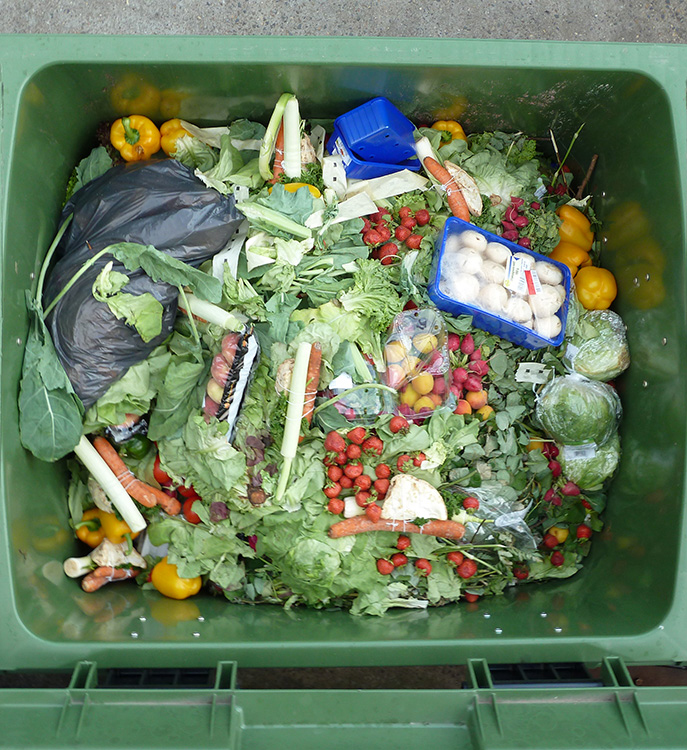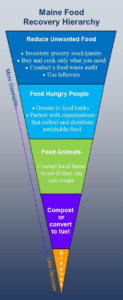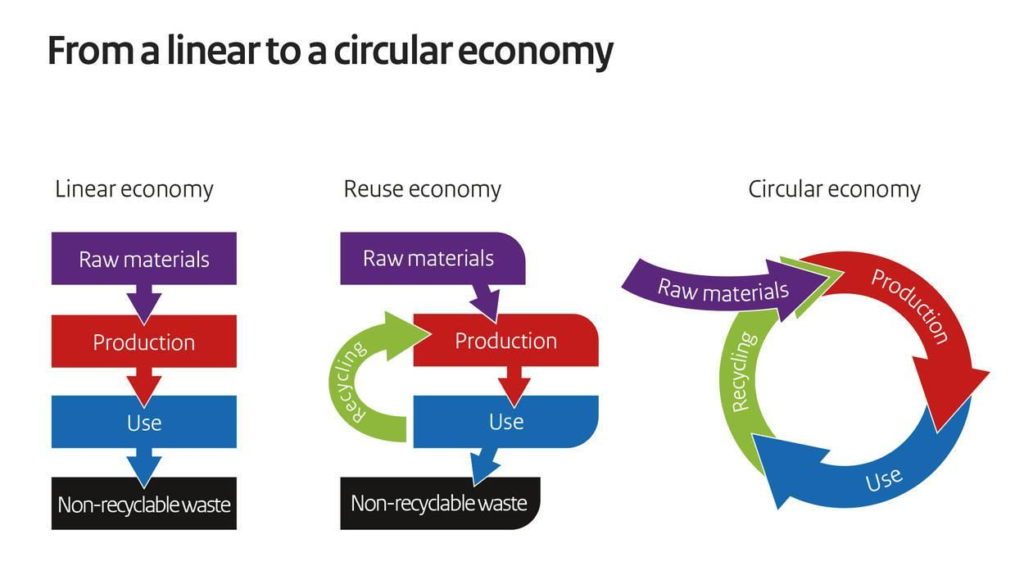Food Waste and Solutions for Combating the Crisis
By Julia Iannuzzi ’21
Food waste is a dynamic and complex issue. The issue of food waste ranges from personal to industrial; therefore, there are many contributing factors, such as purchasing preferences, retail standards, excess production, cost, convenience, and more. According to the EPA, food waste is defined as “food such as plate waste (i.e., food that has been served but not eaten), spoiled food, or peels and rinds considered inedible that is sent to feed animals, to be composted or anaerobically digested, or to be landfilled or combusted with energy recovery.”
Food waste affects all three realms of sustainability: environmental, economic, and social. Food waste directly contributes to climate change because decaying food waste in landfills releases methane, a potent greenhouse gas. Methane is released via the anaerobic decomposition of organic material. Food waste also contributes to food scarcity and economic difficulties, because a lot of the wasted food and wasted resources used to produce the food could have been reallocated to those suffering from food insecurity. The global cost of food wastage, according to the Food and Agriculture Organization of the United Nations (FAO 2014), is $2.6 trillion per year. This cost is attributed to the wasted labor and resources that go into the food production process, as well as the value of the wasted food itself. In the United States alone, $408 billion worth of food goes uneaten (ReFED). As of 2018, 12.9% of Maine’s population lives with food insecurity, so it is fair to say that the state is acutely affected by the hardships of food waste (Feeding America, 2018). Nationwide, one in six Americans is impacted by food insecurity and this issue has been increasingly prevalent since the COVID-19 pandemic began (ReFED). While food waste disposal is costly, management techniques for reducing or recovering wasted food offer solutions that save money. Even non-consumable food scraps, such as banana peels, can be composted, which is a cheaper solution than traditional landfill management. The issue of food waste is more urgent and more complicated now than ever before.
Minimizing food waste is a climate change mitigation strategy that helps reduce harmful greenhouse gases. Fortunately, there are myriad solutions to combat this global problem. It is important to understand the science behind the issue before tackling the solutions. The global food supply chain alone accounts for ~26% of global greenhouse gas emissions, and a quarter of those emissions are due to food waste. Therefore, roughly 6.5% of global emissions are a result of food waste worldwide (Poore & Nemecek 2018). In the United States, food waste accounts for 4% of greenhouse gas emissions (ReFED). The food waste “ends up rotting in landfills where organic matter accounts for 16 percent of U.S. methane emissions” (EPA). Methane is a major contributor to global warming. As a greenhouse gas, it is 84 times more potent than carbon dioxide over a 20-year period, and its atmospheric concentration has increased dramatically in recent decades. Because of the potent global warming potential of methane, reduction of its emissions into the atmosphere is a major priority in our battle against climate change. Although food waste is a worldwide, systemic issue, it is important to recognize that solutions can be as accessible as in our own backyards.
Triple bottom line solutions to the issue will be discussed through the framework of the Mitchell Center team project, “Food Waste Management: Empowering Maine Businesses Towards Sustainability.” The primary investigator for this project is Susanne Lee, a former Executive-in-Residence at the Maine Business School and now a Faculty Fellow at the Mitchell Center for Sustainable Solutions. Prior to joining the Mitchell Center, Lee taught an introductory course on business management and was fascinated by the course’s final topic, which was sustainable business and marketing. Prior to this, she had never put much thought into the crossover between sustainability and business. Upon first teaching this topic, Lee was inspired by Patagonia’s sustainability efforts, and she noticed that students were more engaged with this material compared to other course material. She claims, “It was the best response I got from the students all [year].” This is when Lee discovered her passion for sustainability.
Since 2019, Lee has been working on a project with the Mitchell Center that focuses on solving the issue of food waste. She combines her years of experience within the business realm with her newfound interest in the world of sustainability. Mitchell Center faculty suggested that she begin working on this project to end food waste in Maine, and she hasn’t looked back. “I really feel the most worthwhile use of my time and talents is to be in this sustainability area of business” (Lee).
The Mitchell Center project, “Food Waste Management: Empowering Maine Businesses Towards Sustainability,” takes the ‘triple bottom line’ approach, in which businesses are encouraged to equally prioritize their monetary profits with their environmental and social responsibilities. This ideology is woven throughout the solutions offered to stakeholders within the project. The proposed solutions also follow the principles of reduction, recovery, and recycling as shown in the Maine Food Recovery Hierarchy, included below.
This Mitchell Center project aims to rework the food system in Maine from a linear one to a circular one, stating “linear systems are inherently wasteful because valuable inputs go in and yet the end step is a landfill” (Lee). In a linear system, which is the current model, there is a simple relationship from production to consumption, in which the end result is waste. The goal of the circular food system is to recycle waste into a resource that can be used to create new products. In order to gain a better understanding of how this issue is being tackled within the state of Maine, Lee offers a detailed look into her project. Lee’s team is collaborating with many stakeholders in Maine’s food-related industries, such as grocery stores, farms, restaurants, and hospitals. Key stakeholders include Hannaford, Northern Light: Maine Coast Hospital, City of Portland, and the Maine DEP, as well as many others.
Lee says many of the stakeholders were interested in collaborating with her and her team because they had already realized issues with their food waste management and thought there were more efficient ways to reduce waste. Six solutions were developed through stakeholder collaboration, each one focusing on either reduction, recovery, or recycling. The solutions are:
1. Enable all Maine producers to simply measure and track all food usage
2. Create a Maine “food rescue” matching system
3. Promote statewide consumer and producer food waste education
4. Build Maine’s food handling and processing infrastructure
5. Provide producers with donation education and assistance
6. Remove food waste from landfills and support producer waste diversion.
Solution 1 encourages businesses to use pre-existing food waste tracking technology. This will make businesses aware of the money they are wasting on food that never gets consumed or goes to waste.
Solution 2 utilizes a web-based system that matches locally-available food with local food needs and volunteers to transport the food.
Solution 3 encourages consumer education and awareness about the food system and the waste that it generates. It encourages people to see the true value of the food they are purchasing. Student and consumer food waste education programs are currently in development and will be launched in schools statewide. There is a general lack of awareness of this issue, so implementing educational programs in schools is an effective way to engage and educate the public.
Solution 4 aims to connect key members of the food system to create synergy among the handling and processing stakeholders. Primary issues to be addressed are transportation availability, storage limitations, and restrictions associated with food donation. This solution also focuses on ‘upcycling’ food that is already in the system, e.g. turning local tomatoes into tomato sauce and increasing demand for canning and processing food for longer-term storage. According to Lee, the food upcycling industry used to be abundant in Maine.
Solution 5 works hand in hand with solution 2 to link available food to people who are in need. The primary goal of this solution is to educate stakeholders on food donation tax incentives, legal protection, and offer guidance on relevant Maine governmental agencies.
Solution 6 aims to increase available options for composting and other alternatives to disposal of food in landfills. By developing better practices to divert food waste from landfills, such as community practices, statewide cost savings will be possible.
These six solutions are being worked on through the Mitchell Center by Susanne Lee and her team. They work with many stakeholders and are persuading business owners to adapt food waste solutions in their practices. While the project’s food waste solutions are primarily aimed at businesses, they can also be easily adapted to fit our individual lifestyles. Overarching takeaways from this set of solutions are the importance of education on the issue of food waste and accessibility to landfill alternatives.
Food waste is a pressing societal issue that touches everyone around the globe and contributes to the larger issue of global climate change. Luckily, there are viable solutions to reducing food waste from landfills, such as those proposed by Lee’s food waste project. The solutions can be implemented on both small and large scales. Fortunately, businesses benefit from the reduction of food waste economically, socially, and on a broader scale, environmentally. Redirecting excess food towards those with limited access is helpful to communities. Reducing the amount of food that goes to waste helps businesses save money and reduces the emissions of methane, a powerful greenhouse gas. Educating the public about the benefits of reducing food waste will encourage businesses and consumers to monitor their waste more closely. Everybody can be a part of the solution to food waste, from large corporations to our small communities. Education is a meaningful first step. More information can be found on the Mitchell Center for Sustainable Solutions website.
Resources:
Sustainable management of Food basics. (2021, January 13). Retrieved April 06, 2021
Map the Meal Gap. (n.d.). Retrieved December 05, 2020
Food Wastage Footprint. (n.d.). Retrieved December 05, 2020
Food Wastage Footprint Full Cost Accounting(Rep.). (n.d.).



